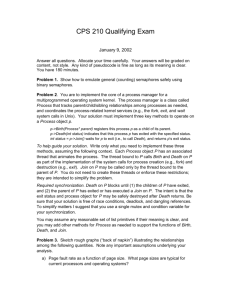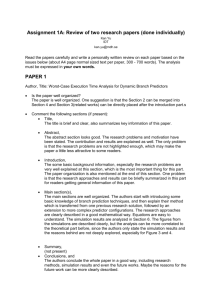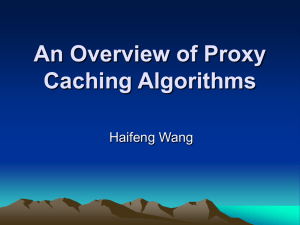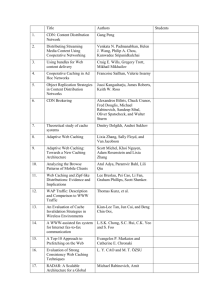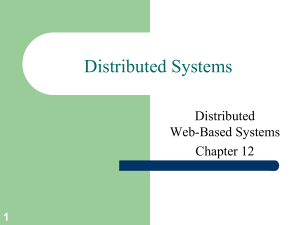A Minimal Access Cost-Based Multimedia Object Replacement Algorithm
advertisement
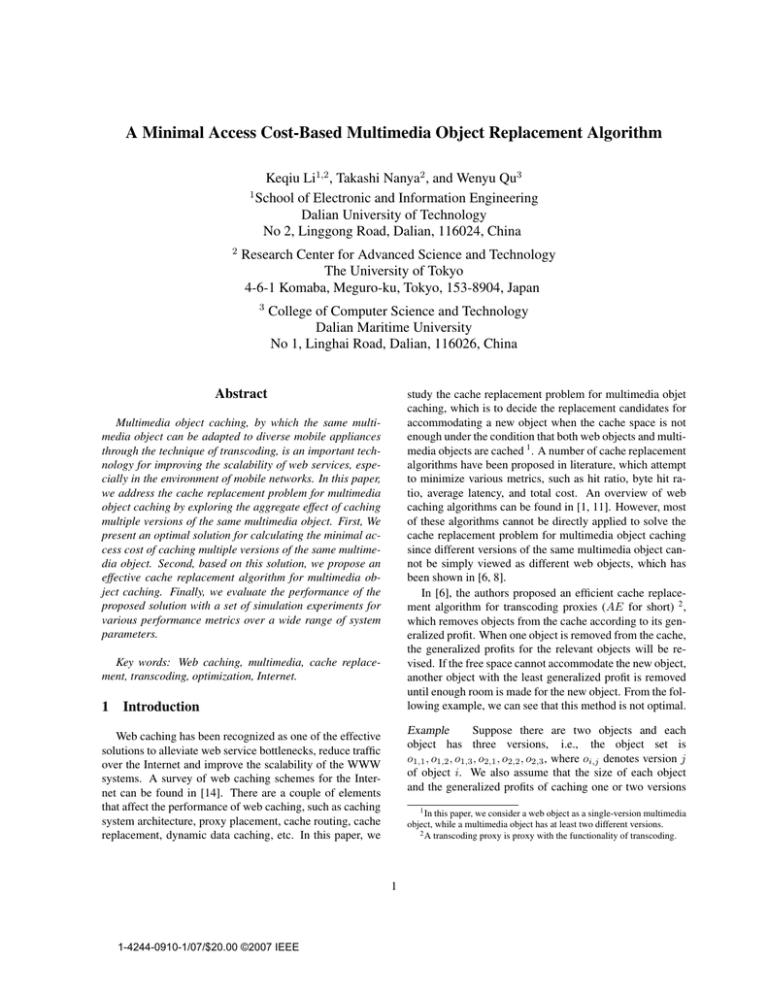
A Minimal Access Cost-Based Multimedia Object Replacement Algorithm
Keqiu Li1,2 , Takashi Nanya2 , and Wenyu Qu3
1
School of Electronic and Information Engineering
Dalian University of Technology
No 2, Linggong Road, Dalian, 116024, China
2
Research Center for Advanced Science and Technology
The University of Tokyo
4-6-1 Komaba, Meguro-ku, Tokyo, 153-8904, Japan
3
College of Computer Science and Technology
Dalian Maritime University
No 1, Linghai Road, Dalian, 116026, China
Abstract
study the cache replacement problem for multimedia objet
caching, which is to decide the replacement candidates for
accommodating a new object when the cache space is not
enough under the condition that both web objects and multimedia objects are cached 1 . A number of cache replacement
algorithms have been proposed in literature, which attempt
to minimize various metrics, such as hit ratio, byte hit ratio, average latency, and total cost. An overview of web
caching algorithms can be found in [1, 11]. However, most
of these algorithms cannot be directly applied to solve the
cache replacement problem for multimedia object caching
since different versions of the same multimedia object cannot be simply viewed as different web objects, which has
been shown in [6, 8].
In [6], the authors proposed an efficient cache replacement algorithm for transcoding proxies (AE for short) 2 ,
which removes objects from the cache according to its generalized profit. When one object is removed from the cache,
the generalized profits for the relevant objects will be revised. If the free space cannot accommodate the new object,
another object with the least generalized profit is removed
until enough room is made for the new object. From the following example, we can see that this method is not optimal.
Multimedia object caching, by which the same multimedia object can be adapted to diverse mobile appliances
through the technique of transcoding, is an important technology for improving the scalability of web services, especially in the environment of mobile networks. In this paper,
we address the cache replacement problem for multimedia
object caching by exploring the aggregate effect of caching
multiple versions of the same multimedia object. First, We
present an optimal solution for calculating the minimal access cost of caching multiple versions of the same multimedia object. Second, based on this solution, we propose an
effective cache replacement algorithm for multimedia object caching. Finally, we evaluate the performance of the
proposed solution with a set of simulation experiments for
various performance metrics over a wide range of system
parameters.
Key words: Web caching, multimedia, cache replacement, transcoding, optimization, Internet.
1
Introduction
Example
Suppose there are two objects and each
object has three versions, i.e., the object set is
o1,1 , o1,2 , o1,3 , o2,1 , o2,2 , o2,3 , where oi,j denotes version j
of object i. We also assume that the size of each object
and the generalized profits of caching one or two versions
Web caching has been recognized as one of the effective
solutions to alleviate web service bottlenecks, reduce traffic
over the Internet and improve the scalability of the WWW
systems. A survey of web caching schemes for the Internet can be found in [14]. There are a couple of elements
that affect the performance of web caching, such as caching
system architecture, proxy placement, cache routing, cache
replacement, dynamic data caching, etc. In this paper, we
1 In this paper, we consider a web object as a single-version multimedia
object, while a multimedia object has at least two different versions.
2 A transcoding proxy is proxy with the functionality of transcoding.
1
1-4244-0910-1/07/$20.00 ©2007 IEEE
s(o1,1 )
3
p(o1,1 )
18
p(o1,1 , o1,2 )
29
Table 1. Data Used in the Example
s(o1,2 )
s(o1,3 )
s(o2,1 )
s(o2,2 )
2
1
3
2
p(o1,2 )
p(o1,3 )
p(o2,1 )
p(o2,2 )
20
16
16
18
p(o1,1 , o1,3 ) p(o1,2 , o1,3 ) p(o2,1 , o2,2 ) p(o2,1 , o2,3 )
25
28
26
30
of each object are shown in Table 1, where s(·) and p(·)
denote the size and the profit, respectively.
If an object with size 2 is to be inserted, it is obvious
that object o2,1 should be removed because it has the least
generalized profit, and its size is enough to accommodate
the new object. In this case, AE is efficient. If an object
with size 4 is to be inserted, AE will first remove object
o2,1 from the cache, and then remove o1,3 from the cache
because these two are the ones with the least profits, and the
total size of them is enough for the new object. The profit
we lose by removing these two objects is 32. We can see
AE is not efficient in this case because the profit we lose is
25 when o1,1 and o1,3 are removed. The main reason is that
the aggregate profit of caching multiple versions of the same
object is not the simple summation of that of each version.
Furthermore, considering all the objects cached makes this
problem more complex.
2
s(o2,3 )
1
p(o2,3 )
18
p(o2,2 , o2,3 )
28
Object Transcoding
Transcoding is a technology that is used to transform a
multimedia object from one version to another, frequently
through trading off object fidelity for size [5, 7, 12, 13].
The relationship among different versions of a multimedia
object can be expressed by a weighted transcoding graph
[6]. An example of such a graph is shown in Figure 1.
In Figure 1, we can see that the original version A1 can
From the above example, we can see that studying the
cache replacement problem for multimedia object caching
has significance on both theory and practice.
The main contributions of this paper are summarized as
follows.
Figure 1. A Weighted Transcoding Graph
• We propose an optimal solution for calculating the
minimal access cost of caching multiple versions of
the same multimedia object.
be transcoded to each of the less detailed versions A2 , A3 ,
A4 , and A5 . It should be noted that not every Ai can be
transcoded to Aj since it is possible that Ai does not contain enough content information for the from Ai to Aj .
The transcoding cost from Ai to Aj of a multimedia object is denoted by t(Ai , Aj ), which is defined as the delay for transcoding one version to another for the same
multimedia object. Obviously, t(Ai , Ai ) = 0. If a version cannot be transcoded from another version, we consider the transcoding cost as infinity. If version Aj can
be transcoded from version Ai through version Ak with
i < k < j, then t(Ai , Aj ) ≤ t(Ai , Ak ) + t(Ak , Aj ) (triangularity property) because version Ak is always an option
if the transcoding cost t(Ai , Aj ) is too large. In this paper,
the transcoding graph is a linear array and the transcoding
cost between any two adjacent versions is constant (T ), i.e.,
j−1
t(Ai , Aj ) =
t(Ak , Ak+1 ) = (j − i)+ T , where x+ = x
• Based on this solution, we propose an effective cache
replacement algorithm for multimedia object caching.
• We evaluate the performance of the proposed solution
with a set of simulation experiments for various performance metrics over a wide range of system parameters.
The rest of this paper is organized as follows. Section
2 introduces some preliminary concepts of transcoding. In
Sections 3, we present an optimal solution for the problem
of multimedia object replacement and its analysis. The simulation model and performance evaluation are described in
Sections 4 and 5, respectively. Section 6 summarizes our
work and concludes the paper.
k=i
2
if x ≥ 0 else x+ = ∞. Our analysis can be easily extended for the case in which the transcoding graph is a general transcoding graph as defined in the beginning of this
section.
3
follows:
⎧ k−1
k+δ−1
⎪
⎪
⎪
f
L
+
fi (i − k)T
⎪
i
i
⎪
⎪
⎪
i=1
i=k
⎪
⎪
m
⎪
⎨
+
fi Li (k + δ ≤ m)
C(Ak ) =
⎪
i=k+δ
⎪
⎪
⎪
k−1
m
⎪
⎪
⎪
⎪
f
L
+
fi (i − k)T (k + δ > m)
i i
⎪
⎪
⎩ i=1
i=k
An Effective Cache Replacement Algorithm for Multimedia Object Caching
(2)
It is easy to see that C(A1 ) can be calculated in O(m)
time. Thus, each C(A2 ), C(A3 ), · · · , C(Am ) can be done
in constant time; Therefore, the AC-1 problem can be
solved in O(m) time. Therefore, based on the cost function
as given in Equation (1), the AC-1 problem of caching only
one version (i.e., n = 1) from the set {A1 , A2 , · · · , Am }
can be solved in O(m) time.
The second step is to extend the above solution to compute the optimal solution for caching two versions, Ak1 and
Ak2 , at the same time at node v.
Suppose that Ak1 and Ak2 are the two optimal versions
to be cached. The key observation here is that Ak1 is also an
optimal solution for the problem with {A1 , A2 , · · · , Ak2 −1 }
if k1 < k2 , because the requests for {Ak2 , Ak2 +1 , · · · , Am }
can only be served by Ak2 . Regarding to this observation,
we have the following lemma.
For the cache replacement problem, only the node with
a cache and the server are considered 3 . Assume that
a multimedia object O has m different versions, denoted
by A1 , A2 , · · · , Am , where A1 is the most detailed version and Am is the least detailed version. For version Ai
(1 ≤ i ≤ m), we associate the link between the cache and
the server a nonnegative cost Li , which is defined as the
cost of sending a request for version Ai and the relevant response over the link. So we have L1 ≥ L2 ≥ · · · ≥ Lm .
In this paper, we define this cost as the transmission cost.
Obviously, Let fi be access frequency of version Ai from
the cache.
Before presenting the cache replacement algorithm for
multimedia object caching, we calculate the access cost of
caching k versions of a multimedia object (AC-k problem
for short), where 1 ≤ k ≤ m. In [9], we studied this problem under the assumption that L1 = L2 = · · · = Lm = L.
Lemma 1 Assume that Abp and Abq are the optimal solutions for the problem of caching only one version from
the set of {A1 , A2 , · · · , Ap−1 } and {A1 , A2 , · · · , Aq−1 } respectively, then we have bp ≤ bq if p < q.
First, we begin by computing the access cost of caching
only one version Ak at the cache with 1 ≤ k ≤ m.
Now we discuss how a request for a specific version is
served. Obviously, the requests for the versions that cannot be transcoded from Ai shall be served by the server,
while some of the requests for Ai with i ≥ k, depending
on the transcoding cost and the transmission cost, will be
taken care of by transcoding from version Ak . Therefore,
the total access cost of caching only version Ak at the cache
is computed as follows:
C(Ak ) =
k−1
i=1
fi Li +
m
fi min{(i − k)T, Li }
Proof Without loss of generality, it is sufficient for us
to prove that bp ≤ bp+1 where 1 ≤ bp ≤ p − 1 and
1 ≤ bp+1 ≤ p. The proof is by contradiction. Assume
that we have bp > bp+1 . As Abp is the optimal version
to be cached, we have C1,p (Abp ) < C1,p (Abp+1 ), where
C1,p (Ai ) denotes the access cost of caching Ai for the
MOP problem with {A1 , A2 , · · · , Ap−1 }. From the definition of the access cost function C1,p as given in Equation
(1), adding Ap to the set {A1 , A2 , · · · , Ap−1 } will increase
both C1,p (Abp ) and C1,p (Abp+1 ) by fp min{(p − bp )T, Lp }
and fp min{(p − bp+1 )T, Lp } respectively. The increase
to C1,p (Abp+1 ) is no less than that to C1,p (Abp ) because
bp > bp+1 . So we have C1,p+1 (Abp ) < C1,p+1 (Abp+1 ),
which contradicts the fact that C1,p+1 (Abp+1 ) is the minimum access cost of caching Abp+1 for the problem with
{A1 , A2 , · · · , Ap−1 , Ap }. Hence the lemma is proven.
(1)
i=k
Since only version Ak is cached, there must exist an integer
δ such that (δ − i)T < Li and (δ − i − 1)T ≥ Li−1 .
Therefore, δ is such a parameter that the request for version
Ai will be served by the cache if 0 < i < δ, and the request
for version Ai will be served by the server if i ≥ δ.
Based on Equation (1), C(Ak ) can be further defined as
Based on Lemma 3, we can see that the feasible range of
the optimal solution for the problem with {A1 , A2 , · · · , Aq }
can be reduced if the optimal version for the problem
with {A1 , A2 , · · · , Ap } has been obtained. So is the
3 Here, the server can be a cache, which holds a version of a multimedia
object.
3
is cached at node v. Dp is defined as follows:
other case when the optimal solution for the problem with
{A1 , A2 , · · · , Aq } is known, the feasible range of the optimal solution for the problem with {A1 , A2 , · · · , Ap } is also
reduced. Therefore, we can find Abp and compute C1,p (Ap )
by divide and conquer.
⎧ p+δ−1
m
⎪
⎪
⎪
fi (i − p)T +
fi Li
⎪
⎪
⎪
⎨ i=p
i=p+δ
Dp =
if p + δ ≤ m
⎪
m
⎪
⎪
⎪
⎪
fi (i − p)T if p + δ > m
⎪
⎩
(k)
Let Dp,q denote the minimum access cost of caching k
versions for the AC-1 problem with q − p versions, i.e.,
Ap , Ap+1 , · · · , Aq−1 , where 1 ≤ p < q ≤ m. Thus,
(1)
(1)
D1,p = C1,p (Abp ) and D1,m+1 = min {C1,m+1 (Ak )}.
i=p
1≤k≤m
(2)
(2)
• Step 3: Compute D1,m , where D1,m is the minimum
access cost of caching two versions for the problem
(2)
with {A1 , A2 , · · · , Am }. D1,m is calculated as follows:
Based on Lemma 3, we have the following theorem on the
(1)
time complexity of computing D1,p for 1 < p ≤ m.
Theorem 1 All
the
m
AC-1
problems
for
(1)
{A1 , A2 , · · · , Ap } where 1 ≤ p ≤ m, i.e., D1,p for
1 < p ≤ m, can be computed in O(m log m) time.
(2)
(1)
D1,m = min {D1,p + Dp )}
2≤p≤m
(2)
It is easy to show that D1,m is the minimum access cost
of caching two versions for the AC-2 problem and the time
(2)
complexity of computing D1,m is O(m log m).
Proof Assume that there exists an integer θ such that m =
(1)
2θ , then we can compute D1, 1 m in O(m) time. Assume
2
that Ab m is the optimal solution for the problem of caching
2
only one version with {A1 , A2 , · · · , A m2 −1 }, then we can
find the optimal solution for the problem of caching only
one version for {A1 , A2 , · · · , A m4 } in O(m) time. Simi-
(1)
After we have calculated D1,p for 1 ≤ p ≤ m in Step
1, we can obtain
(1)
4
(1)
4
(1)
for all 2 ≤ p ≤ m in another
(2)
O(m log m) time by divide and conquer, where D1,p is
the minimum access cost of caching only two versions for
the problem with p − 1 versions, i.e., A1 , A2 , · · · , Ap−1 .
The main idea is similar to Lemma 3 in the finding of
(1)
D1,p . Assume that Abp1 and Abp2 with 1 ≤ bp1 <
bp2 < p are the two optimal versions cached in node v
for A1 , A2 , · · · , Ap−1 to achieve the optimal access cost
(2)
D1,p . Similarly, Abq1 and Abq2 with 1 ≤ bq1 < bq2 <
q are the two optimal versions cached in node v for
(2)
A1 , A2 , · · · , Aq−1 to achieve the optimal access cost D1,q .
We can show with a similar argument with Lemma 3 that
bp2 ≤ bq2 if p < q and this property limits the range of
searching for the optimal solutions. As in Theorem 3, the
(2)
two optimal solutions in D1, m can be found in O(m) time
larly, D1, 3m can also be computed by solving the problem
4
}.
of caching only one version with {A1 , A2 , · · · , A 3m
4 −1
As we have already computed C1, m2 (Ay ) where y =
min(b m2 , m
2 − 1), we can base on this result to com(Ay ) for {A1 , A2 , · · · , A 3m
} (by adding
pute C1, 3m
4
4 −1
m (A m
at most m
terms
to
C
).
We
then compute
1,
−1
4
2
2
3m (Ay+1 ), · · · , C
3m (A 3m
(A
),
C
) in at most
C1, 3m
y
1, 4
1, 4
4
4 −1
O( 3m
−
y)
time.
So
it
takes
at
most
O(m)
time
to com4
(1)
(1)
pute D1, m and D1, 3m . According to the similar decompo(1)
(2)
D1,p
(1)
sition, D1, m , D1, 3m , D1, 5m , and D1, 7m can all be solved
8
8
8
8
in O(m) time. After repeating this process log m times, we
(1)
can finish computing D1,p for 1 < p ≤ m. Hence, the
theorem is proven.
2
(1)
after knowing the optimal versions of D1,p for 1 < p ≤ m;
(2)
(2)
(2)
then D1, m and D1, 3m in another O(m) time; then D2, m ,
(2)
Now we can accomplish the problem of caching two versions in the following three steps.
4
(2)
4
(2)
8
(2)
D1, 3m ,D1, 5m , and D1, 7m in another O(m) time until D1,p
8
8
8
for 2 < p ≤ m are found after log m times. Therefore,
the minimum access cost of caching three versions, de(3)
(3)
noted by D1,m , can be computed similarly, i.e., D1,m =
(1)
• Step 1: Evaluate D1,p for 1 < p ≤ m, where
(1)
D1,p denotes the minimum access cost of caching only
one version for the AC-1 problem with p − 1 ver(1)
sions, i.e., A1 , A2 , · · · , Ap−1 . In particular, D1,m+1 =
min {C1,m+1 (Ak )}.
(2)
min {D1,p + Dp )}, with at most O(m log m) time. Us-
3≤p≤m
ing the same idea, we can solve the problem of caching K
versions in O(Km log m) time.
(K)
Let D1,m denote the minimum access cost of caching K
versions from m versions, i.e., A1 , A2 , · · · , Am , then it is
(K)
easy to show that D1,m can be computed in O(Km log m)
time.
1≤k≤m
• Step 2: Evaluate Dp for 2 ≤ p ≤ m, where Dp is
the access cost for versions Ap , Ap+1 , · · · , Am if Ap
4
Based on the above analysis, we can present a cache
replacement algorithm for multimedia object caching such
that the total size of the removed objects is greater than the
size of the new object and the generalized cost loss of the
removed objects is minimized. Here, the generalized cost
loss of the removed objects is defined as the total access
cost when they are not cached divided by their total size.
Suppose there are n different objects cached and the size
of a new object to be cached is sN ew , then we should find
a subset of objects O∗ ⊆ O that satisfies the following
conditions:
si,j ≥ sN ew
1.
oi,j ∈O ∗
Table 2. The Cache replacement Algorithm
1
INSERT oN ew INTO C
2
k=0
3
S ∗ (k) = 0
4
WHILE Sc − Su − S ∗ (k) < sN ew DO
5
k =k+1
6
FOR i = 1 TO n DO
7
CALCULATE R∗ (i, k)
8
CALCULATE R∗ (k)
analysis, it is easy to see that the running time of Step 6
n
l · mi log mi ) since there are n different objects
is O(
2. C(O∗ )/S(O∗ ) ≤ C(O )/S(O ), ∀ O ⊆ O,
where O∗
=
{o∗1,1 , o∗1,2 , · · · , o∗1,α1 , o∗2,1 , o∗2,2 , · · · ,
o∗2,α2 , · · · , o∗β,1 , o∗β,2 , · · · , o∗β,αβ } is the set of objects to be removed, O = {o1,1 , o1,2 , · · · , o1,m1 ,
o2,1 , o2,2 , · · · , o2,m2 , · · · , on,1 , on,2 , · · · , on,mn } is the set
β
C(o∗i,1 , o∗i,2 , · · · , o∗i,αi ),
of objects cached, C(O∗ ) =
i=1
i=1
and the running time for object i for removing l versions
of object i is O(l · mi log mi ), where mi is the number
of versions of object i. The running time for Step 8 is
O((n + l) log (n + l)) because we should order all n + l
items to find the minimal one among them. Thus, the
total running time for the proposed algorithm (Step 4)is
k
n
l ·mi log mi ]) = O(n2 log n)
O( [(l +n)log(l +n)+
and S(O∗ ) is the total size of all the objects in O∗ . C(O )
and S(O ) can be similarly defined. Obviously, (1) is to
make enough room for the new object, and (2) is to evict
those objects whose generalized aggregate cost saving is
minimized.
Before we present the algorithm, we give some notations used in the algorithm. Let R∗ (i, k) denote the minimal generalized aggregate cost loss of removing k versions
of object i and R∗ (k) denote the minimal generalized cost
loss of the k objects removed. We can see that the k objects removed can be k versions of a multimedia object or
different versions of different multimedia objects, i.e., k
can be decomposed as k = k1 + k2 + · · · + kn , where
0 ≤ ki < k is the number of versions of object i that are in
the set of the k objects removed. It can be easily proved that
there are k different such combinations in all. Therefore,
we have R∗ (k) = min{R∗ (1, k), R∗ (2, k), · · · , R∗ (n, k),
min
{R∗ (k1 )+R∗ (k2 )+· · ·+R∗ (kn )}}. We de-
l=1
i=1
since k ≤ n and mi n. Hence, the theorem is proven.
From Theorem 3, we know that the time complexity of
the proposed algorithm depends on k, i.e., the number of
objects to be removed. In practical execution, we always
stop the execution of searching the objects to be removed to
make room for the new object when k arrives at a certain
number. This is based on the fact that it is not beneficial to
remove many objects to accommodate only one object. So
the practical time complexity of the proposed algorithm is
O(n log n), which is the same as that of the algorithm proposed in [6]. However, from the algorithm we know that
we have to search the entire cache for the other versions
of the object and then recalculate the generalized aggregate
cost savings for them whenever we insert or evict an object into or from the cache. Such operations are, in general,
very costly. Here, we can save calculated results for later
computation, which will save a lot of computations.
k=k1 +k2 +···+kn
note the set of all the objects that achieves R∗ (k) by O∗ (k)
and their total size is S ∗ (k). In the algorithm, C is used to
hold the cached objects, Sc is the cache capacity, Su is the
cache capacity used, oN ew is the object to be cached, and
its size is sN ew . The algorithm is shown in Table 2.
Regarding to the time complexity of this algorithm, we
have the following theorem.
4
Simulation Model
To the best of our knowledge, it is difficult to find true
trace data in the open literature to execute such simulations.
Therefore, we generated the simulation model from the empirical results presented in [2, 3, 4, 6].
The network topology was randomly generated by the
Tier program [4]. Experiments for many topologies with
various parameters were conducted and the performance
of our solution was found to be insensitive to topology
Theorem 2 The time complexity of the proposed algorithm
is O(n2 log n), where n is the total number of different objects cached.
Proof The running time of the proposed algorithm mainly
depends on Steps 4, 6, and 8. Based on the previous
5
Table 3. Parameters Used in Simulation
Parameter
Value
Delay of Fetching Objects
Exponential Distribution (θ = 1.5Sec)
Web Object Size Distribution
Pareto Distribution (µ = 6KB)
Web Object Access Frequency
Zipf-Like Distribution (α = 0.7)
Average Request Rate
U (1, 9) requests
Transcoding Cost
50KB/Sec
65
changes. Here, only the experimental results for one topology are presented due to space limitations. The characteristics of this topology and the workload model are shown in
Table 3, which were chosen from the open literature and are
considered to be reasonable.
We also assume that each multimedia object has five versions. The sizes of each version are assumed to be 100
percent, 80 percent, 60 percent, 40 percent, and 20 percent
of the original object size. The transcoding delay is determined as the quotient of the object size to the transcoding
rate.
We include the following algorithms for evaluating our
replacement solution proposed in Section 3.
60
DSR (%)
55
50
45
40
OA
AE
LNC−R
LRU
35
0
5
10
15
Cache Capacity (%)
Figure 2. Experiments for DSR
1.4
OA
AE
LNC−R
LRU
1.2
• LRU : Least Recently Used (LRU ) evicts the web object which was requested the least recently.
RRR (Sec/MB)
1
• LN C − R [10]: Least Normalized Cost Replacement
(LN C − R) removes the least profitable documents.
0.8
0.6
0.4
0.2
• AE [6]: Aggregate Effect (AE) selects the object with
the least generalized profit for replacement.
0
0
5
10
15
Cache Capacity (%)
Figure 3. Experiments for RRR
5
Performance Evaluation
6
In this section, we compare the performance results of
our solution with those solutions introduced in Section 4,
in terms of several performance metrics. The performance
metrics we used in our simulation include delay-saving ratio (DSR), defined as the fraction of communication and
server delays which is saved by satisfying the references
from the cache instead of the server; request response ratio
(RRR), defined as the ratio of the access latency of the target object to its size; and object hit ratio (OHR), defined as
the ratio of the number of requests satisfied by the caches
as a whole to the total number of requests. In the following
figures, LRU , LN C − R, and AE denote the results for
the solutions introduced in Section 4, OA denotes the optimal solution proposed in Section 3. Due to space limitation,
we will not give the detailed description on the performance
improvement of our solution
Conclusions
In this paper, we addressed the cache replacement problem for multimedia object caching and proposed an effective algorithm for soling this problem. A set of simulation
experiments were conducted to study the performance of
our solution. The simulation results show that our solution
improves network performance compared with existing solutions.
References
[1] A. Balamash and M. Krunz. An Overview of Web
Caching Replacement Algorithms. IEEE Communications surveys, Vol. 6, No. 2, pp.44-56, 2004.
6
100
[10] P. Scheuermann, J. Shim, and R. Ving ralek. A
Case for Delay-Conscious Caching of Web Documents. Computer Networks and ISDN Systems, Vol.
29, No. 8-13, pp. 997-1005, 1997.
90
80
OHR (%)
70
60
[11] S. Podlipnig and L. Boszormenyi. A Survey of Web
cache Replaceemnt Strategies. ACM Computing Syrveys, Vol. 35, No. 4, pp. 374-398, December 2003.
50
40
30
OA
AE
LNC−R
LRU
20
10
0
5
10
[12] B. Shen, S.-J. Lee, and S. Basu. Caching Strategies
in Transcoding-Enabled Proxy Systems for Streaming
Media Distribution Networks. IEEE Trans on Multemidia, Vol. 6, No. 2, pp. 375-386, 2004.
15
Cache Capacity (%)
Figure 4. Experiments for OHR
[13] A. Vetro, C. Christopoulos, and H. Sun. Video
Transcoding Architectures and Techniques: An
Overview. IEEE Signal Processing Magazine, Vol. 20,
No. 2, pp. 18-29, 2003.
[2] P. Barford and M. Crovella. Generating Representive
Web Workloads for Network and Server Performance
Evaluation. Proc. ACM SIGMETRICS’98, pp. 151160, 1998.
[14] J. Wang. A Survey of Web Caching Schemes for the Internet. ACM Computer Communication Review, Vol.
29, No. 5, pp. 36-46, 1999.
[3] L. Breslau, P. Cao, L. Fan, G. Phillips, and S. Shenker.
Web Caching and Zipf-like Distributions: Evidence
and Implications. Proc. IEEE INFOCOM’99, pp. 126134, 1999.
[4] K. L. Calvert, M. B. Doar, and E. W. Zegura. Modelling Internet Topology. IEEE Communications Magazine, Vol. 35, No. 6, pp. 160-163, 1997.
[5] S. Chandra, C. Ellis, and A. Vahdat. Application-Level
Differentiated Multimedia Web Services Using Quality
Aware Transcoding. IEEE Journal on Selected Areas
in Communications, Vol. 18, No. 12, pp. 2544-2565,
2000.
[6] C. Chang and M. Chen. On Exploring Aggregate
Effect for Efficient Cache Replacement in Transcoding Proxies. IEEE Transactions on Parallel and Distributed Systems, Vol. 14, No. 6, pp. 611-624, June
2003.
[7] R. Han, P. Bhagwat, R. LaMaire, T. Mummert, V. Perret, and J. Rubas. Dynamic Adaptation in An Image
Transcoding Proxy for Mobile Web Browsing. IEEE
Personal Communications, Vol. 5, No. 6, pp. 8-17,
1998.
[8] K. Li, H. Shen, and F. Chin. Placement Solutions
for Multiple Versions of a Multimedia Object. Proc.
of The 8th IEEE International Symposium on Objectoriented Real-time distributed Computing, pp. 224231, May 2005.
[9] K. Li, H. Shen, K. Tajima, and L. Huang. An Effective
Cache Replacement Algorithm for Transcoding Proxy
Caching. Journal of Supercomputing, Vol. 35, No. 2,
pp. 165-184, 2006.
7

